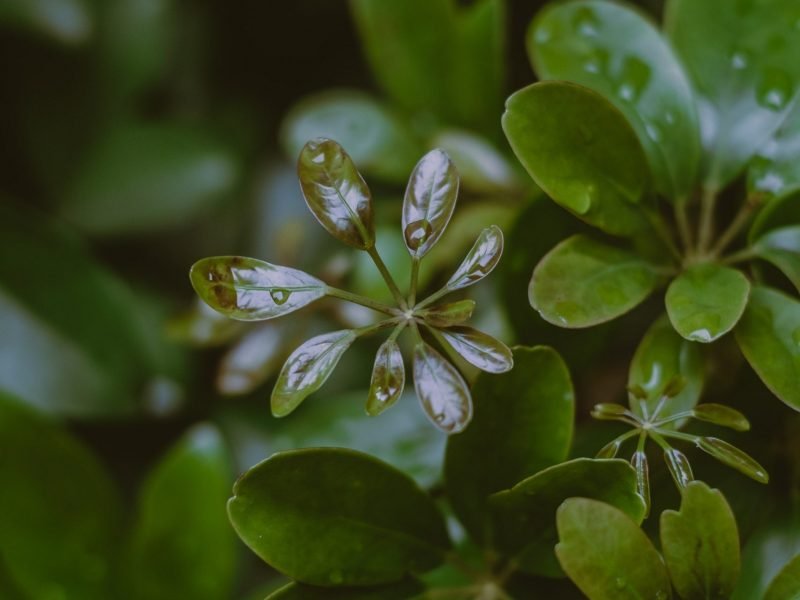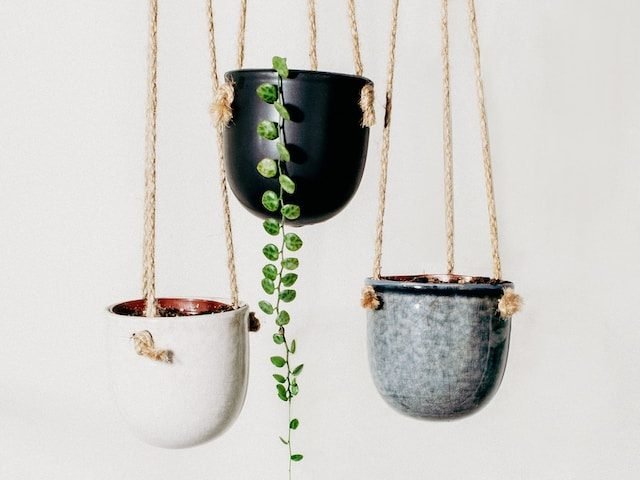
Schefflera plants (also known as Umbrella plants due to their unique leaves) are becoming more and more popular in the houseplant world as they are fairly easy to take care of.
However, if you find that your Schefflera’s leaves are turning brown/yellow, this is usually a sign of unhappiness in either their environment or care routine. The most common reasons why your Schefflera is turning brown or yellow are: overwatering, underwatering, extreme temperatures or chemical sensitivity.
Overwatering could be causing brown leaves
Schefflera are pretty hardy plants and won’t die on you suddenly if overwatered every once in a while. However, consistent overwatering will mean their roots will start to rot and their leaves will start to turn brown, mushy and fall off. Schefflera need to be watered no more than twice a week in the hottest months of the year, and less frequently in autumn and winter.
Consistent overwatering will lead the main root system to rot which is very harmful to your Schefflera. It will cause the plant to become unstable, the individual leaves will droop, turn brown and eventually fall off completely as your Schefflera will not be able to get nutrients from the soil to maintain healthy leaves or new growth.
If you think that you may have overwatered your Schefflera it is best to replace the soil straight away rather than just sit and wait for it to dry up over time. Make sure to replace it with something fresh and nutrient rich, like this one from Miracle Gro. Be careful when removing the soil from the roots as you don’t want to cause any further damage.
Before watering your Schefflera, make sure to always check the moisture in the soil. There are two really easy ways to make sure that it definitely needs water. First check the moisture in the top 2cm of the soil, if it is still damp then wait a few days before watering again. You can also lift up your Schefflera to check the weight of the plant before and after watering. You will then start to be able to gauge how heavy the soil is when it is in need of water.
Handle your Schefflera gently when picking it up to prevent any leaves from breaking away from the main stem.
If you want to take all of the guess work out you could use a moisture meter to keep an eye on the moisture level, these affordable little gauges are a great way to make sure you’re not overwatering and damaging your plants. You could even invest in self-watering pots, like these ones from Amazon, that make sure your plants are always getting just what they need.
Drainage issues could be the problem
Sometimes it may not be your watering schedule that is causing your Schefflera’s leaves to turn brown but the poor water drainage of the soil and pot. You can very easily increase the amount of drainage in the pot by mixing in a small amount of perlite, this will make it far easier for water to flow through and out of the drainage holes of your pots (you should also check to make sure your pots have drainage holes). Another easy step is to add a few small stones or pebbles to the bottom of your pots, this helps in making sure that the drainage holes don’t get blocked by soil or any loose debris.
Although clay or terracotta pots can be a little bit more expensive and breakable than plastic ones, their upsides are much more than just the aesthetic. The clay they’re made of is permeable which means that some of the water in your soil can evaporate through the sides of the pot. This isn’t the case for the plastic pots that our plants often come in, which instead hold in all of that moisture. So sometimes it is worth investing a little more to make sure that the roots of your Schefflera are not sitting in too much moisture.
Complete Houseplant Care eBook
Our comprehensive (and rather good looking) eBook that will teach you everything you need to know to successfully care for, and maintain your houseplants!
Buy onUnderwatering your Schefflera can also cause brown leaves
Like overwatering, too little water can also be harmful to your Schefflera. Although it won’t die on you suddenly if you forget to water it every once in a while, or make it go a little longer without water whilst you are on holiday, consistent underwatering will start to have an impact on your Schefflera’s health. If you notice that you Schefflera’s leaves are turning brown and crisping up, it may be due to underwatering, as it prioritises new healthy growth over its older leaves.
Stick a finger in the top few centimetres of the soil to check the moisture. You can also try lifting your Schefflera as we mentioned earlier to see it if feels particularly light. If you find that your Schefflera feels very dry, water it a little every other day for a week. Your first instinct might be to give it loads of water straight away but this can actually be harmful to your Schefflera if the soil goes from one extreme to the other. Instead, you want to reintroduce frequent watering for a week or two and this should solve the problem.
If you find yourself forgetting to water your Schefflera regularly, try creating a calendar of when all your houseplants need watering. You can then set reminders on your phone on specific days to remind you. That way you can keep track of your watering habits and make sure you don’t under or overwater any of them too often!
This is another problem that can be easily resolved by investing in an affordable self-watering pot, these handy pots take all of guess work out of watering and make everything so much easier!
Low humidity levels cause brown leaves
Alongside watering habits, low humidity can also be a cause of brown leaves on a Schefflera. Often our homes can have quite dry air, especially in the winter months where we often have the heating on for most of the day. A lack of humidity in the air can cause the leaves to be a little limp, droop down, and turn dry, brown and crispy (usually starting from the tips of the leaves).
But luckily for you, it can be pretty simple to increase the humidity for your Schefflera, these are our top tips:
Misting the leaves
One of the simplest ways to increase the humidity for your Schefflera is to mist them with a spray bottle a couple of times a week. Make sure the water is fresh and at room temperature as you don’t want to cause temperature shock.
Pebble tray
Place your Schefflera over a tray of pebbles with fresh water over the top. Over the day water from the tray will evaporate giving your plant exactly what they’re looking for.
Give your Schefflera a shower
To quickly raise the humidity and wash down your plant of any long-standing dust, you can always give them a quick shower. Simply pop them in the shower and wash them down with lukewarm water, this will clean off the leaves and give the soil a good soaking.
You do want to be quite careful when doing this with your Schefflera as their stems are not always super sturdy. Keep the water pressure low and the shower head fairly close to the leaves and you should be alright.
Move your Schefflera to the bathroom
If you’re lucky enough to have great lighting in your bathroom you can move your Schefflera in there to increase the humidity. The running water from your showers means your bathroom is probably one of the most humid in your home.
Buy a humidifier
They’re relatively affordable little devices and they make keeping a consistent humidity level so much easier.
Most will allow you to place them on a timer so they run on a fixed schedule, and some will even have a built-in monitor so they automatically turn on and off to keep the humidity exactly where you want it. This one is our favourite, and it actually looks nice too!
Extreme temperatures can lead to brown leaves
Schefflera Plants don’t like rapid changes in temperature, so you should make sure you keep them out of areas that are often have a draft, for example drafty doors, windows or air conditioning vents.
You should also keep them away from heating vents and radiators as the hot dry air that is produced can quickly turn your Schefflera’s leaves brown. Try moving your Schefflera to a spot with a consistent temperature and keep an eye on any changes for a few weeks.
Chemical sensitivity
If you notice that the tips of your Schefflera are starting to turn brown and dry it may be due to sensitivity to chemicals in the water. The salts, chlorine and fluoride found in tap water can build up in the soil. Over time, this may be causing harm to the roots which often shows itself in brown leaves.
There are two ways to make sure that the water you give them has reduced levels of these chemicals. Firstly you can leave a jug of tap water for around 24 hours to allow for a lot of the chemicals to evaporate.
Another method is leaving a tray outside to collect rainwater to give to your houseplants to make sure chemical levels are lower than the treated water that comes out of your tap. Note that this will be more common if you live in a hard water area.
Too much fertiliser at once
Schefflera Plants don’t need regular fertilisation, in fact, they will thrive without being fertilised at all. However, if you do want to, we recommend giving your Schefflera a water-based fertiliser no more than once a year, in the growing period.
If you are fertilising your Schefflera more regularly, it may be causing damage to the main root system which over time could kill your plant. If you have over-fertilised your Schefflera, we recommend changing out the soil and washing down the roots to get rid of any excess that has built up over time.
There are quite a few reasons why your Schefflera’s leaves may be turning brown, so it is important that you diagnose the right problem and solve it as soon as possible. If there are only a few brown leaves or tips on the plant then you should have caught it early enough and your plant should resume healthy growth after you have identified the problem.
Don’t expect the brown leaves to all of a sudden turn luscious green, what’s done is done, unfortunately. But you can carefully trim away the brown parts of the leaves to get your plant to focus its energy on new healthy growth. You might also want to propagate your Schefflera to save some of the healthy sections of your plant.















